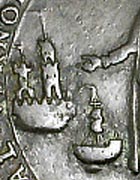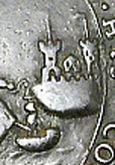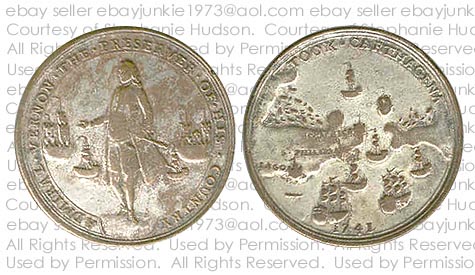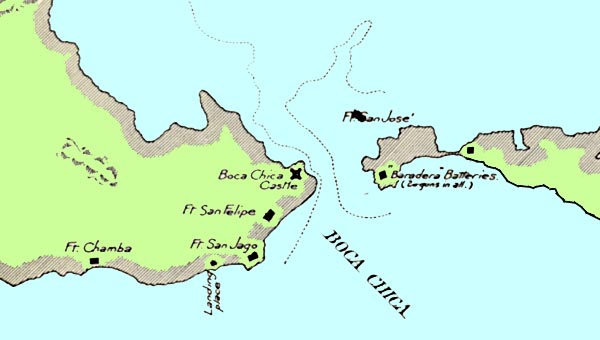| Obverse Design | Legend curving above says "ADMIRAL . VERNON . THE . PRESERVER . OF . HIS . COUNTRY". There is a line enclosing the legend. A full length Vernon is facing 3/4 to the left; his right hand is extended and in his left hand is a baton. The point of his sword extends out from under his coat and touches the mast of the ship behind him. On either side of him is a fort in the distance, and a small ship in front of each fort. The medal has a line just inside the rim and a plain raised edge. | ||||
| Reverse Design | Legend curving along the top says "TOOK . CARTAGENA". There is no line enclosing the legend. Curving slightly along the bottom is the date "1741". The main design is a view of two points of land projecting towards the center of the medal, with numerous small islands above the land. The point on the left has three forts labeled "BOCACHICA", "S. PHILIPS" and "IAGO". Above the strait is an island with a fort labeled "S. IOS". In the foreground two larger ships are sailing to the right. Above them and below the strait three smaller ships are sailing to the left. Further up, above the strait and the "S. IOS" island is another small ship sailing left. The medal has a line just inside the rim and a plain raised edge. | ||||
| Distinctions | There are a total of about eight varieties with a similar obverse and the Cartagena attack on the reverse. Only two varities have this particular Cartegena reverse. This variety has the date 1741 on the reverse at the bottom; the other variety is undated. | ||||
| Detail On Obverse of VN-4.10 | Detail On Obverse of VN-4.10 | ||||
 The ship and fort to the left of Admiral Vernon. |
 The ship and fort to the right of Admiral Vernon. |
||||
| Metal | Brass and copper, or silver-plated. | Weight | Unknown. | Size and Shape | Round, 37 mm in diameter. |
| Rarity | Common. | Designer or Issuer | Not known. | Other Catalog Numbers | Betts #332, McCormick-Goodhart #210. |
| Notes | Between the eight similar obverses there are differences in the designs on either side of Admiral Vernon, which is why I have included close-ups of those designs. However, the reverse design is the easiest way to tell these varieties apart. | ||||
Example of a silver-plated VN-4.10

Scale: 6 pixels equals one millimeter

From Admirals of the Caribbean by Francis Russel Hart